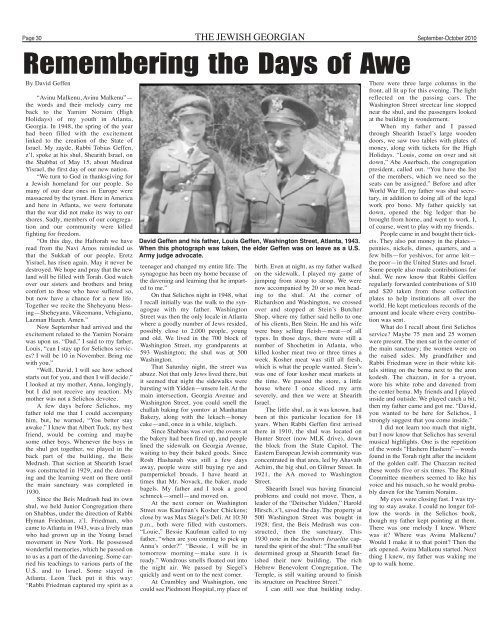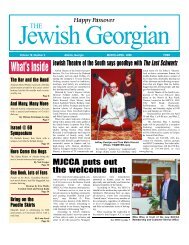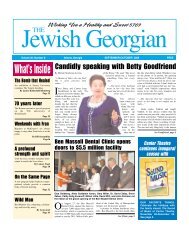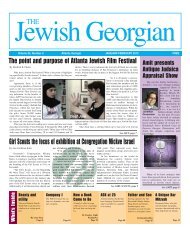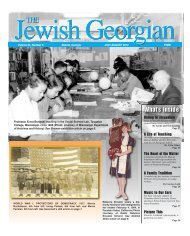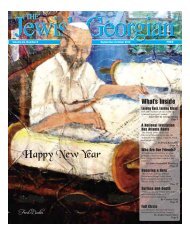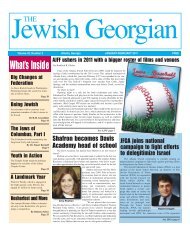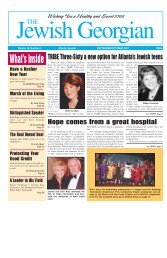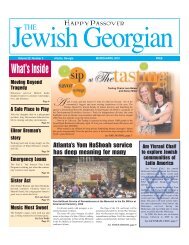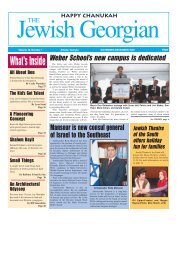What's Inside - The Jewish Georgian
What's Inside - The Jewish Georgian
What's Inside - The Jewish Georgian
Create successful ePaper yourself
Turn your PDF publications into a flip-book with our unique Google optimized e-Paper software.
Page 30 THE JEWISH GEORGIAN September-October 2010<br />
Remembering the Days of Awe<br />
By David Geffen<br />
<strong>The</strong>re were three large columns in the<br />
front, all lit up for this evening. <strong>The</strong> light<br />
“Avinu Malkenu, Avinu Malkenu”—<br />
reflected on the passing cars. <strong>The</strong><br />
the words and their melody carry me<br />
Washington Street streetcar line stopped<br />
back to the Yamim Noraim (High<br />
near the shul, and the passengers looked<br />
Holidays) of my youth in Atlanta,<br />
at the building in wonderment.<br />
Georgia. In 1948, the spring of the year<br />
When my father and I passed<br />
had been filled with the excitement<br />
through Shearith Israel’s large wooden<br />
linked to the creation of the State of<br />
doors, we saw two tables with plates of<br />
Israel. My zayde, Rabbi Tobias Geffen,<br />
money, along with tickets for the High<br />
z’l, spoke at his shul, Shearith Israel, on<br />
Holidays. “Louis, come on over and sit<br />
the Shabbat of May 15, about Medinat<br />
down,” Abe Auerbach, the congregation<br />
Yisrael, the first day of our new nation.<br />
president, called out. “You have the list<br />
“We turn to God in thanksgiving for<br />
of the members, which we need so the<br />
a <strong>Jewish</strong> homeland for our people. So<br />
seats can be assigned.” Before and after<br />
many of our dear ones in Europe were<br />
World War II, my father was shul secre-<br />
massacred by the tyrant. Here in America<br />
tary, in addition to doing all of the legal<br />
and here in Atlanta, we were fortunate<br />
work pro bono. My father quickly sat<br />
that the war did not make its way to our<br />
down, opened the big ledger that he<br />
shores. Sadly, members of our congrega-<br />
brought from home, and went to work. I,<br />
tion and our community were killed<br />
of course, went to play with my friends.<br />
fighting for freedom.<br />
People came in and bought their tick-<br />
“On this day, the Haftorah we have David Geffen and his father, Louis Geffen, Washington Street, Atlanta, 1943. ets. <strong>The</strong>y also put money in the plates—<br />
read from the Navi Amos reminded us When this photograph was taken, the elder Geffen was on leave as a U.S. pennies, nickels, dimes, quarters, and a<br />
that the Sukkah of our people, Eretz Army judge advocate.<br />
few bills—for yeshivos, for arme leit—<br />
Yisrael, has risen again. May it never be<br />
destroyed. We hope and pray that the new<br />
land will be filled with Torah. God watch<br />
over our sisters and brothers and bring<br />
comfort to those who have suffered so,<br />
but now have a chance for a new life.<br />
Together we recite the Sheheyanu blessing—Sheheyanu,<br />
Vikeemanu, Vehigianu,<br />
Lazman Hazeh. Amen.”<br />
Now September had arrived and the<br />
excitement related to the Yamim Noraim<br />
was upon us. “Dad,” I said to my father,<br />
Louis, “can I stay up for Selichos services?<br />
I will be 10 in November. Bring me<br />
with you.”<br />
“Well, David, I will see how school<br />
starts out for you, and then I will decide.”<br />
I looked at my mother, Anna, longingly,<br />
but I did not receive any reaction. My<br />
mother was not a Selichos devotee.<br />
A few days before Selichos, my<br />
father told me that I could accompany<br />
him, but, he warned, “You better stay<br />
awake.” I knew that Albert Tuck, my best<br />
friend, would be coming and maybe<br />
some other boys. Whenever the boys in<br />
the shul got together, we played in the<br />
back part of the building, the Beis<br />
Medrash. That section at Shearith Israel<br />
was constructed in 1929, and the davening<br />
and the learning went on there until<br />
the main sanctuary was completed in<br />
1930.<br />
Since the Beis Medrash had its own<br />
shul, we held Junior Congregation there<br />
on Shabbas, under the direction of Rabbi<br />
Hyman Friedman, z’l. Friedman, who<br />
came to Atlanta in 1943, was a lively man<br />
who had grown up in the Young Israel<br />
movement in New York. He possessed<br />
wonderful memories, which he passed on<br />
to us as a part of the davening. Some carried<br />
his teachings to various parts of the<br />
U.S. and to Israel. Some stayed in<br />
Atlanta. Leon Tuck put it this way:<br />
“Rabbi Friedman captured my spirit as a<br />
teenager and changed my entire life. <strong>The</strong><br />
synagogue has been my home because of<br />
the davening and learning that he imparted<br />
to me.”<br />
On that Selichos night in 1948, what<br />
I recall initially was the walk to the synagogue<br />
with my father. Washington<br />
Street was then the only locale in Atlanta<br />
where a goodly number of Jews resided,<br />
possibly close to 2,000 people, young<br />
and old. We lived in the 700 block of<br />
Washington Street, my grandparents at<br />
593 Washington; the shul was at 500<br />
Washington.<br />
That Saturday night, the street was<br />
abuzz. Not that only Jews lived there, but<br />
it seemed that night the sidewalks were<br />
bursting with Yidden—unsere leit. At the<br />
main intersection, Georgia Avenue and<br />
Washington Street, you could smell the<br />
challah baking for yomtov at Manhattan<br />
Bakery, along with the lekach—honey<br />
cake—and, once in a while, teiglach.<br />
Since Shabbas was over, the ovens at<br />
the bakery had been fired up, and people<br />
lined the sidewalk on Georgia Avenue,<br />
waiting to buy their baked goods. Since<br />
Rosh Hashanah was still a few days<br />
away, people were still buying rye and<br />
pumpernickel breads. I have heard at<br />
times that Mr. Novack, the baker, made<br />
bagels. My father and I took a good<br />
schmeck—smell—and moved on.<br />
At the next corner on Washington<br />
Street was Kaufman’s Kosher Chickens;<br />
close by was Max Siegel’s Deli. At 10:30<br />
p.m., both were filled with customers.<br />
“Louie,” Bessie Kaufman called to my<br />
father, “when are you coming to pick up<br />
Anna’s order?” “Bessie, I will be in<br />
tomorrow morning—make sure it is<br />
ready.” Wondrous smells floated out into<br />
the night air. We passed by Siegel’s<br />
quickly and went on to the next corner.<br />
At Crumbley and Washington, one<br />
could see Piedmont Hospital, my place of<br />
birth. Even at night, as my father walked<br />
on the sidewalk, I played my game of<br />
jumping from stoop to stoop. We were<br />
now accompanied by 20 or so men heading<br />
to the shul. At the corner of<br />
Richardson and Washington, we crossed<br />
over and stopped at Stein’s Butcher<br />
Shop, where my father said hello to one<br />
of his clients, Ben Stein. He and his wife<br />
were busy selling fleish—meat—of all<br />
types. In those days, there were still a<br />
number of Shochetim in Atlanta, who<br />
killed kosher meat two or three times a<br />
week. Kosher meat was still all fresh,<br />
which is what the people wanted. Stein’s<br />
was one of four kosher meat markets at<br />
the time. We passed the store, a little<br />
house where I once sliced my arm<br />
severely, and then we were at Shearith<br />
Israel.<br />
<strong>The</strong> little shul, as it was known, had<br />
been at this particular location for 18<br />
years. When Rabbi Geffen first arrived<br />
there in 1910, the shul was located on<br />
Hunter Street (now MLK drive), down<br />
the block from the State Capitol. <strong>The</strong><br />
Eastern European <strong>Jewish</strong> community was<br />
concentrated in that area, led by Ahavath<br />
Achim, the big shul, on Gilmer Street. In<br />
1921, the AA moved to Washington<br />
Street.<br />
Shearith Israel was having financial<br />
problems and could not move. <strong>The</strong>n, a<br />
leader of the “Deitscher Yidden,” Harold<br />
Hirsch, z’l, saved the day. <strong>The</strong> property at<br />
500 Washington Street was bought in<br />
1928; first, the Beis Medrash was constructed,<br />
then the sanctuary. This<br />
1930 note in the Southern Israelite captured<br />
the spirit of the shul: “<strong>The</strong> small but<br />
determined group at Shearith Israel finished<br />
their new building. <strong>The</strong> rich<br />
Hebrew Benevolent Congregation, <strong>The</strong><br />
Temple, is still waiting around to finish<br />
its structure on Peachtree Street.”<br />
I can still see that building today.<br />
the poor—in the United States and Israel.<br />
Some people also made contributions for<br />
shul. We now know that Rabbi Geffen<br />
regularly forwarded contributions of $10<br />
and $20 taken from these collection<br />
plates to help institutions all over the<br />
world. He kept meticulous records of the<br />
amount and locale where every contribution<br />
was sent.<br />
What do I recall about first Selichos<br />
service? Maybe 75 men and 25 women<br />
were present. <strong>The</strong> men sat in the center of<br />
the main sanctuary; the women were on<br />
the raised sides. My grandfather and<br />
Rabbi Friedman were in their white kittels<br />
sitting on the bema next to the aron<br />
kodesh. <strong>The</strong> chazzan, in for a tryout,<br />
wore his white robe and davened from<br />
the center bema. My friends and I played<br />
inside and outside. We played catch a bit,<br />
then my father came and got me. “David,<br />
you wanted to be here for Selichos, I<br />
strongly suggest that you come inside.”<br />
I did not learn too much that night,<br />
but I now know that Selichos has several<br />
musical highlights. One is the repetition<br />
of the words “Hashem Hashem”—words<br />
found in the Torah right after the incident<br />
of the golden calf. <strong>The</strong> Chazzan recited<br />
these words five or six times. <strong>The</strong> Ritual<br />
Committee members seemed to like his<br />
voice and his nusach, so he would probably<br />
daven for the Yamim Noraim.<br />
My eyes were closing fast. I was trying<br />
to stay awake. I could no longer follow<br />
the words in the Selichos book,<br />
though my father kept pointing at them.<br />
<strong>The</strong>re was one melody I knew. Where<br />
was it? Where was Avinu Malkenu?<br />
Would I make it to that point? <strong>The</strong>n the<br />
ark opened. Avinu Malkenu started. Next<br />
thing I knew, my father was waking me<br />
up to walk home.


